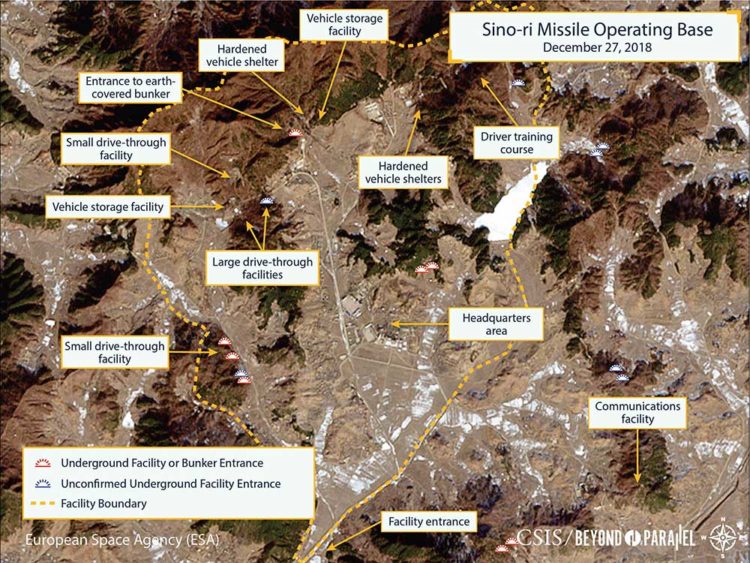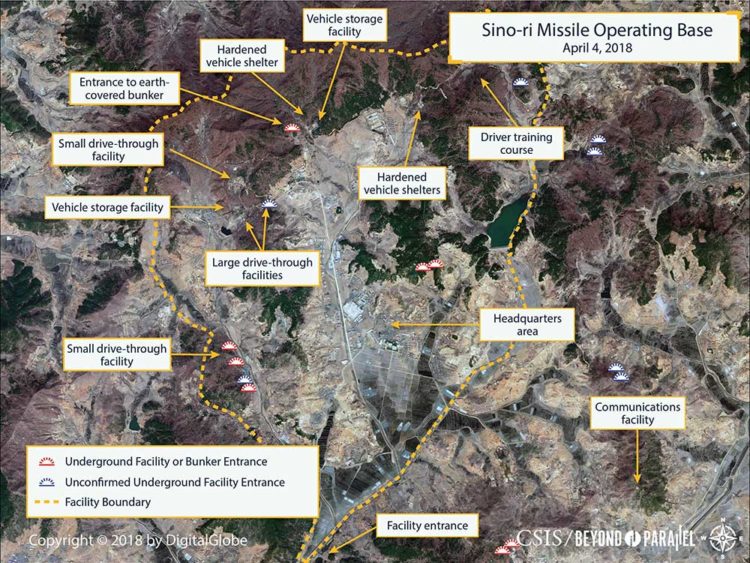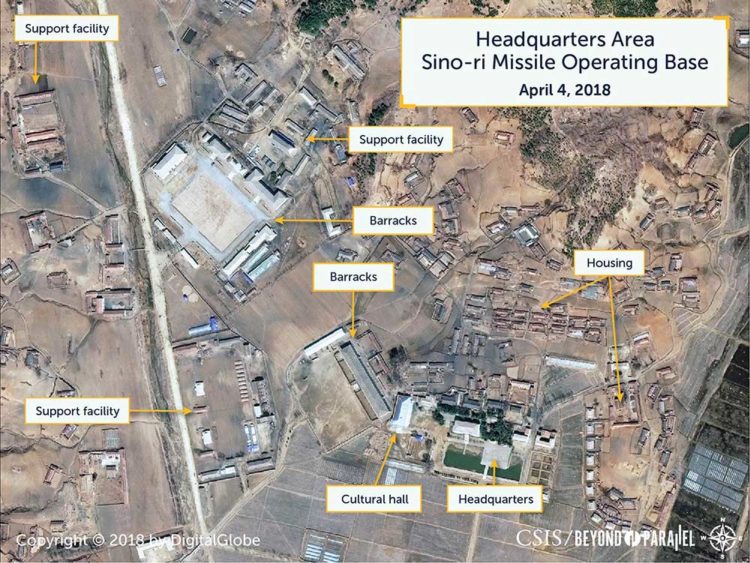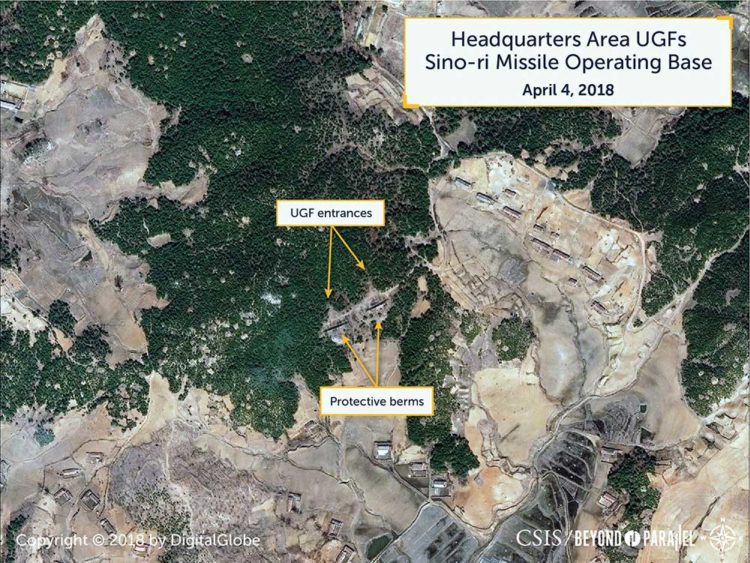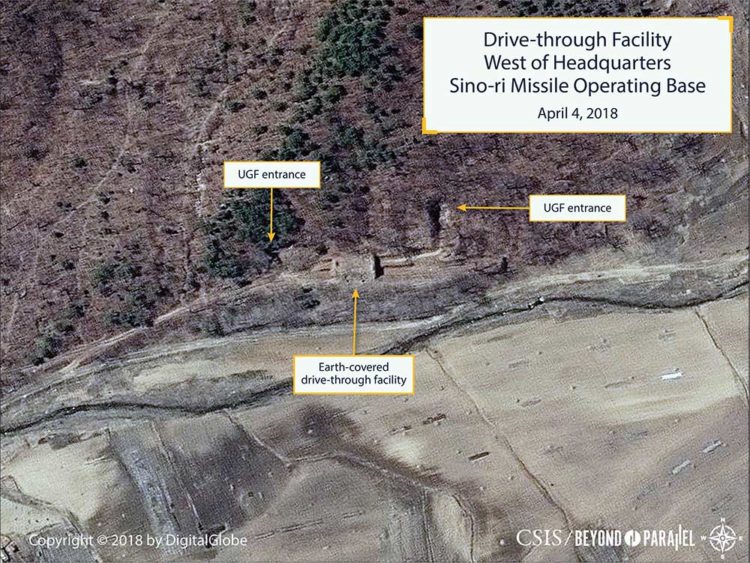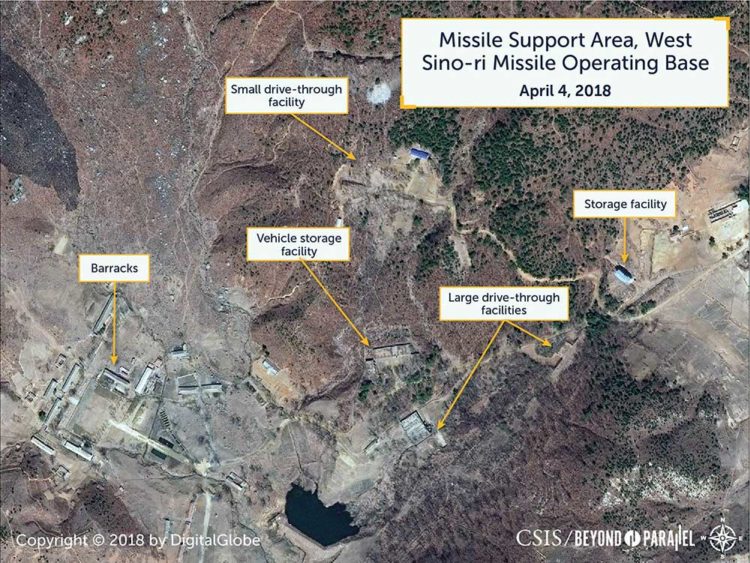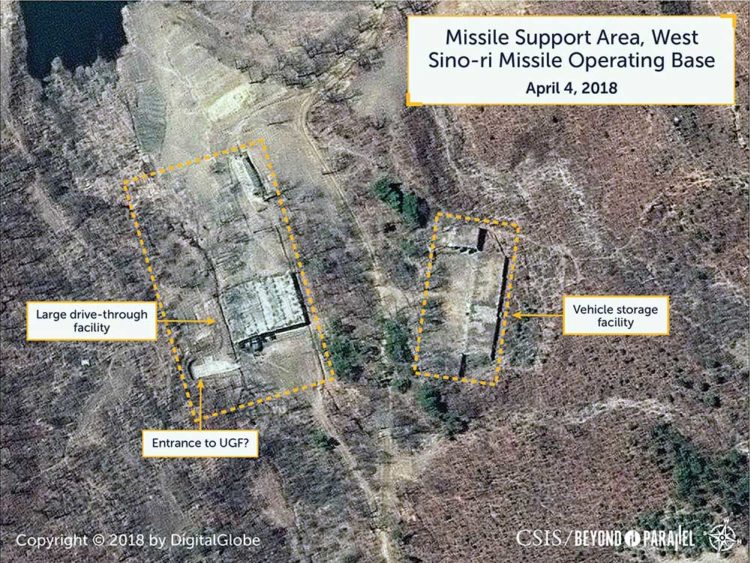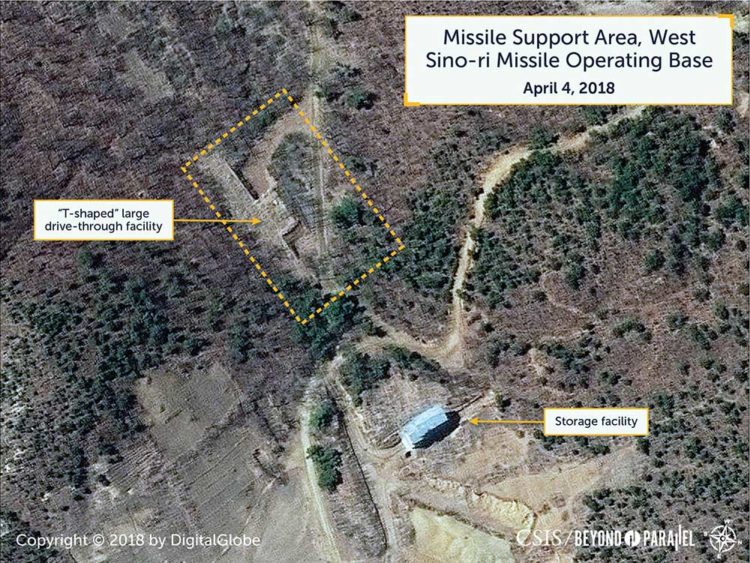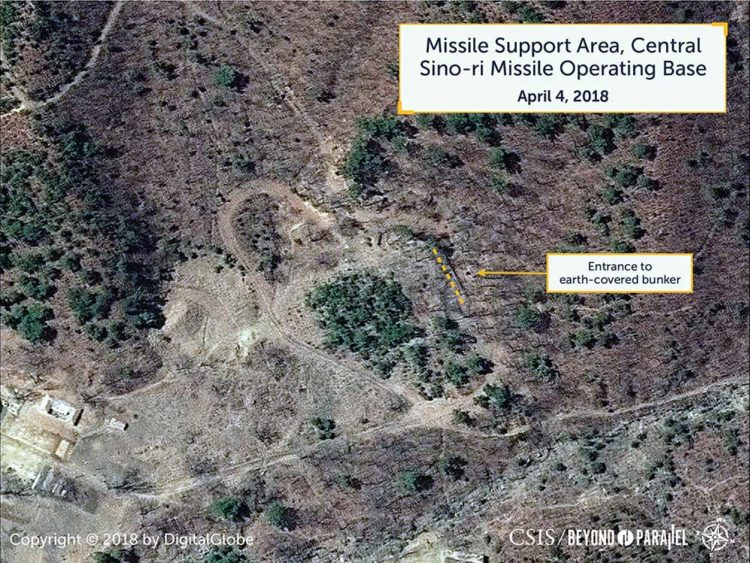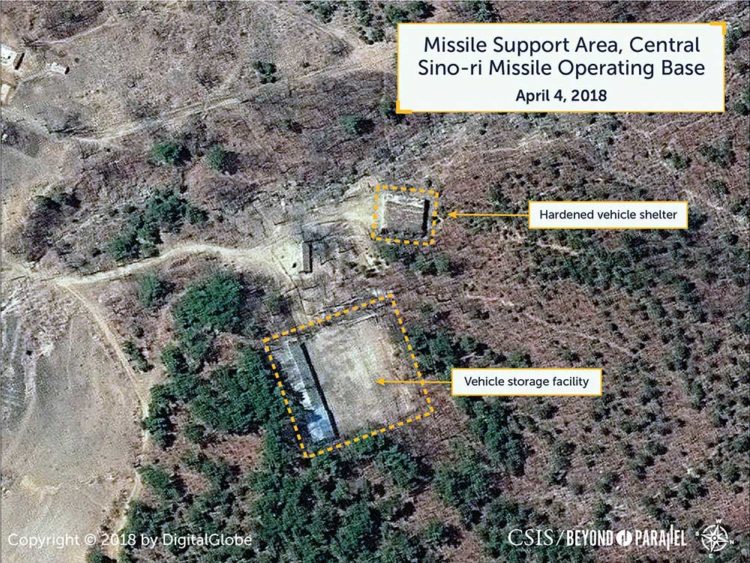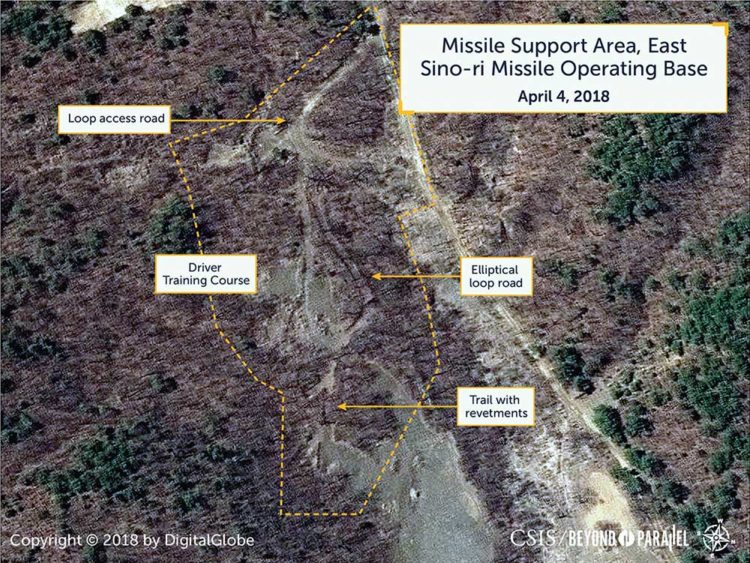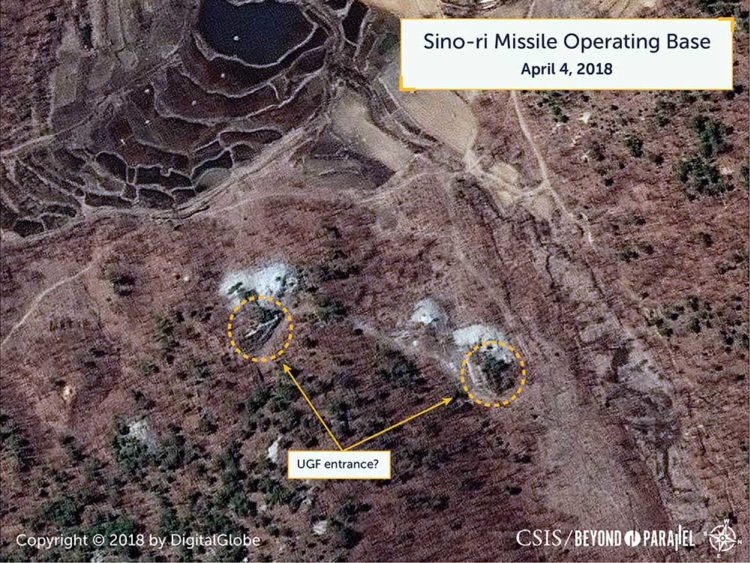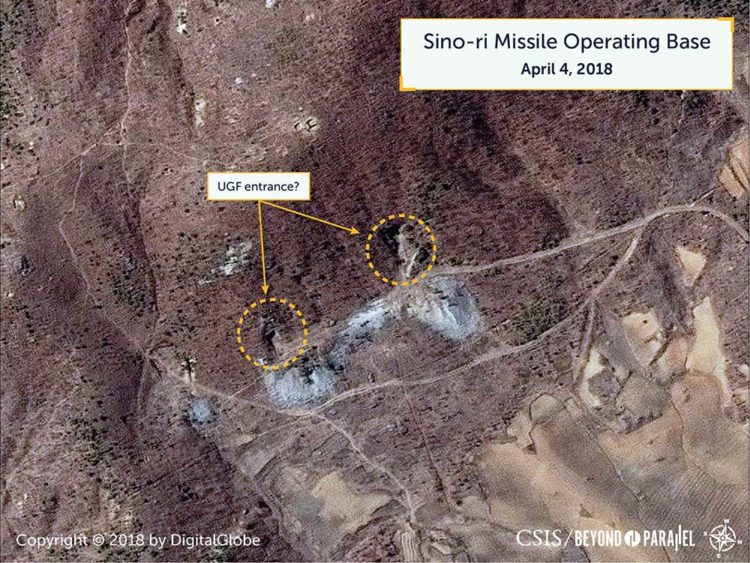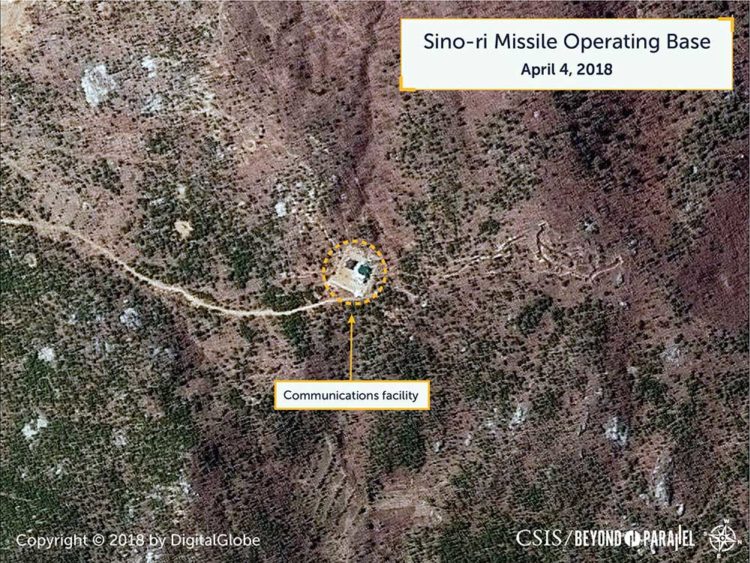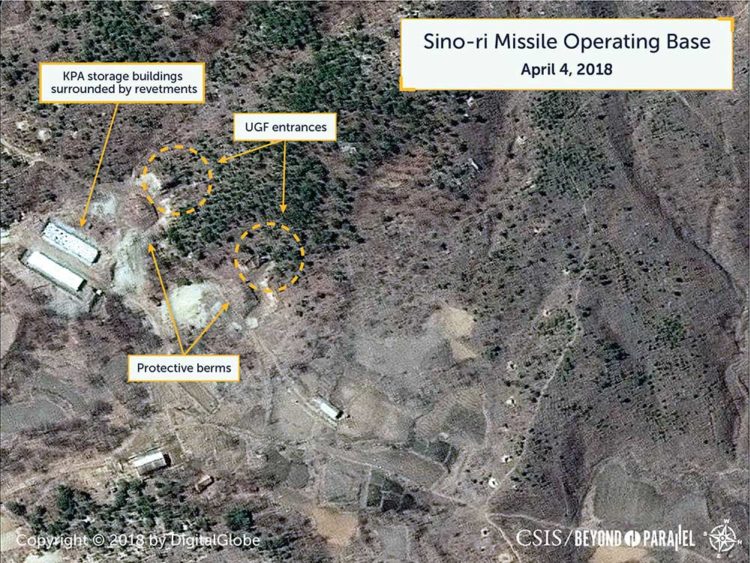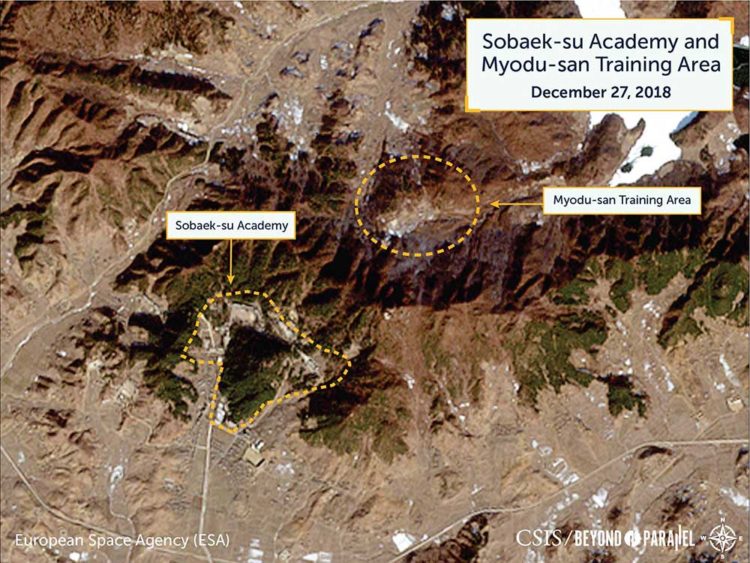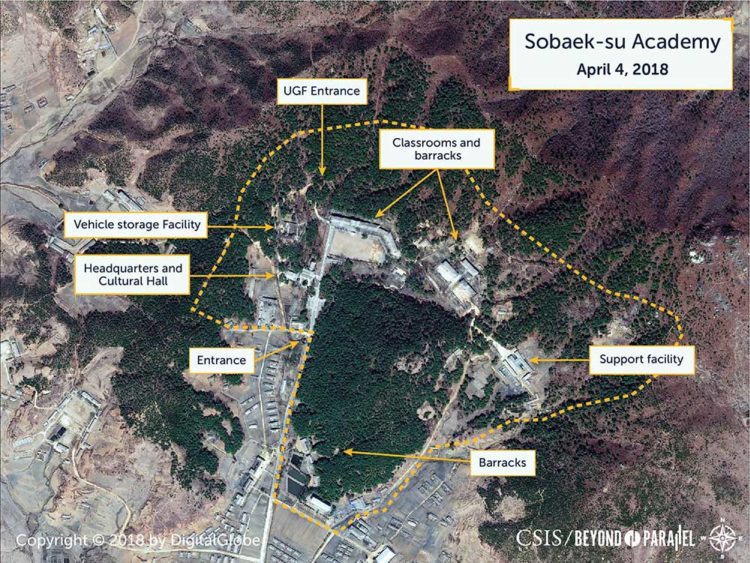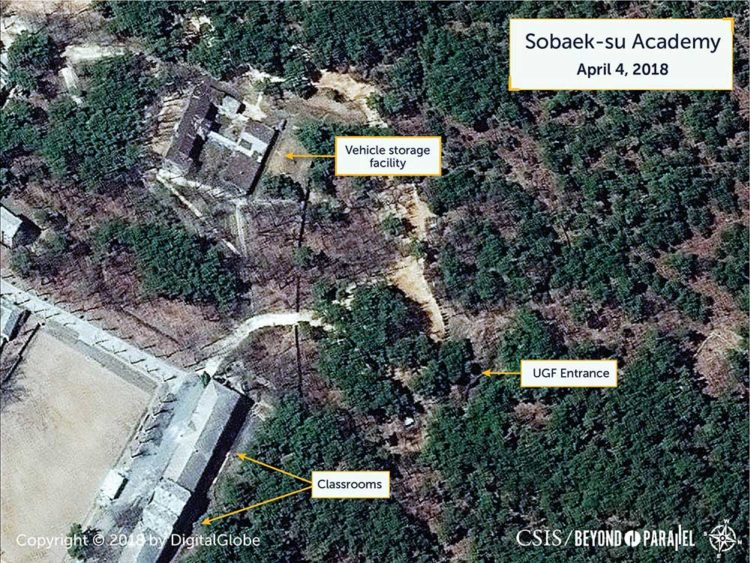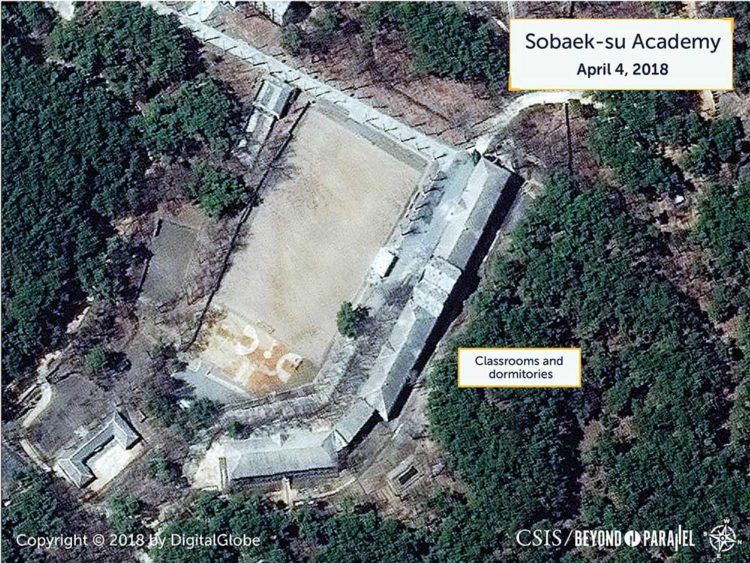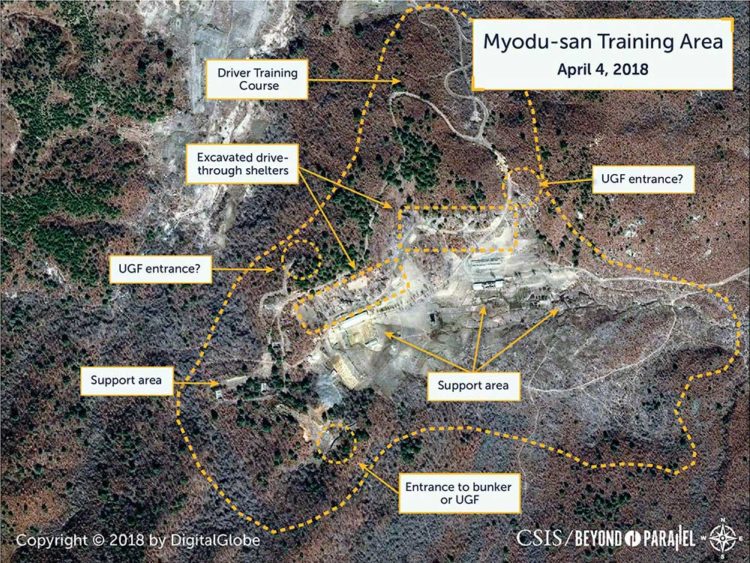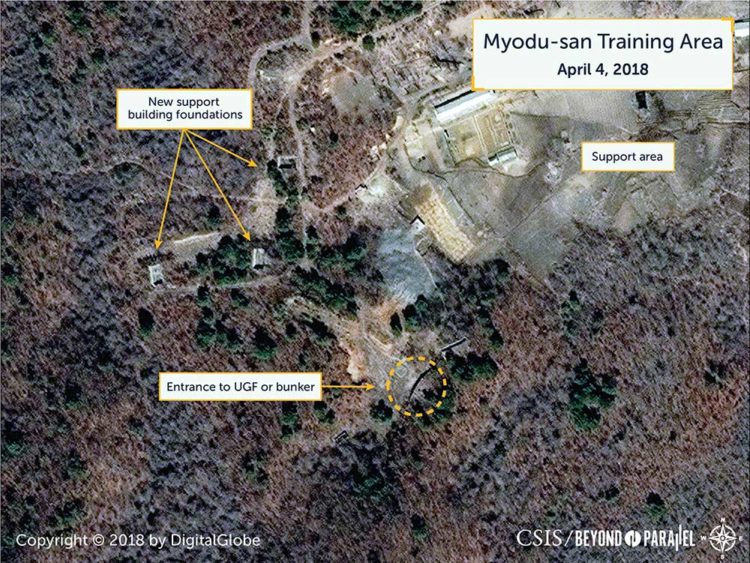
Undeclared North Korea: The Sino-ri Missile Operating Base and Strategic Force Facilities
Key Findings
- Located 212 kilometers north of the DMZ, Sino-ri (신오리) is an operational missile base that houses a regiment-sized unit equipped with Nodong-1 medium-range ballistic missiles (MRBM).
- It is one of the oldest of approximately 20 undeclared missile operating bases and is reported to serve as the headquarters of the Strategic Rocket Forces Nodong missile brigade. It may have also played a role in the development of the newest Pukkuksong-2 (KN-15) ballistic missile first tested or unveiled on February 12, 2017, shortly after Donald Trump’s inauguration as president.
- The Sino-ri missile operating base and the Nodong missiles deployed at this location fit into North Korea’s presumed nuclear military strategy by providing an operational-level nuclear or conventional first strike capability against targets located both throughout the Korean Peninsula and in most of Japan. The base continues to be defended against preemptive attack by nearby anti-aircraft artillery and surface-to-air positions.
- The Sino-ri missile operating base has thus figured prominently in the historical development of the North Korean force serving as one of the first deployments of Scud missiles and later the Nodong medium range ballistic missile.
- The base has often also fulfilled broader missions as both an operational test and development, and training facility for Korean People’s Army (KPA)’s Strategic Force. Beyond Parallel analysis has found that the missile operating base is complemented by two nearby Strategic Force facilities—the Sobaek-su Academy and Myodu-san training area.
- The Sino-ri base has never been declared by North Korea. It also does not appear to be the subject of denuclearization negotiations between the United States and North Korea.
- North Korean missile operating bases would presumably have to be subject to declaration, verification, and dismantlement in any final and fully verifiable denuclearization deal.
- North Korea’s decommissioning of the Sohae satellite launch facility, while gaining much media attention, obscures the military threat to U.S. forces and South Korea from this and other undeclared ballistic missile bases.
- While diplomacy is critical, and should be the primary way to resolve the North Korean nuclear problem, any future agreement must take account of all of the operational missile base facilities that are a threat to U.S. and South Korean security.
Sino-ri Missile Operating Base
The Sino-ri (신오리) missile operating base (39.644929, 125.355288) in Unjon-gun (Unjon County), North Pyongan province, is located in North Korea’s strategic missile belt.1 It sits 77 kilometers northwest of Pyongyang, 212 kilometers north of the demilitarized zone and 270 kilometers northwest of Seoul.2 Although most often referred to as simply a missile operating base, it has fulfilled broader missions as both an operational test and development facility and training facility subordinate to the Strategic Force of the Korean People’s Army (KPA). The KPA Strategic Force is responsible for all ballistic missile units.
In these latter roles, the Sino-ri base appears to have been involved at different times in validating designs and testing capabilities for new launchers, support vehicles, and specialized equipment, etc. It has also been a site for assisting in the development of operational procedures and tactics; and conducting training for ballistic missile personnel and units.3 In addition to housing a Nodong medium-range ballistic missile (MRBM) regiment-sized unit, the Sino-ri missile operating base has been reported to serve as the headquarters for the Strategic Force’s Nodong missile brigade.4 Elements from the Nodong unit based at Sino-ri are reported to have conducted the training launch of two Nodong missiles from the Sukchon area during March 2014.5 Most recently, reports suggest that the base may also have played some role in the development of the Pukkuksong-2 (KN-15) MRBM.6
The Sino-ri missile operating base and the Nodong missiles based here fit into North Korea’s presumed offensive ballistic missile strategy by providing an operational-level first strike capability against targets located both throughout the Korean Peninsula and in most of Japan.
Located approximately 7.5 kilometers northwest of the Sino-ri missile operating base are the Sobaek-su Academy and Myodu-san training area that are also subordinate to the Strategic Force. Preliminary analysis indicates that while the precise nature of their relationships to each other is unknown, they are likely to be centered around a division of responsibilities—Sino-ri for ballistic missile operations and development, Sobaek-su for higher education of Strategic Force personnel, and Myodu-san for ballistic missile training.
Given their subordination to the Strategic Force, close proximity to one another, and complementary—if not overlapping—mission responsibilities, these three organizations as a group serve a unique role within the KPA Strategic Force and are discussed separately in this report.
Development
Although there was a KPA barracks and storage area at Sino-ri since at least the 1960s, it was not until the late 1970s when a FROG-7 battalion was first identified as being deployed there that the facility was associated with North Korea’s nascent ballistic missile program.7 A partially declassified report from August 19, 1982, describes these events and the subsequent deployment of at least a second FROG-7 battalion to the base by 1982.
“Elements of two FROG-7 tactical surface-to-surface missile (TAC SSM) battalions were observed at Sino Ri BKS [barracks] a WPNS [weapons] test FAC [facility] on 1 August. Six canvas-covered FROG-7 TEL [transporter-erector-launchers] were parked in the open between the two double-secured vehicle sheds in the vehicle storage area. This is the first time that more than two FROG-7 TEL have been seen here. The equipment was probably parked in the open because the roof of one of the two large vehicle sheds had been removed for repair. FROG-7 TEL were last seen here [REDACTED] when two were present. Limited sightings of FROG-related equipment at Sino Ri has indicated the presence of only one FROG-7 battalion. However, the presence of six FROG-7 TEL and sufficient vehicle storage capacity for at least two battalion-sized complements of support equipment indicates that the installation has probably housed at least two battalions since the initial identification of FROG-7 here in 1979. The vehicle sheds that house the FROG-7 equipment have been present since at least 1971. [REDACTED]”8

This 1982 report is also the earliest known reference to Sino-ri as a weapons test facility—a role that it apparently intermittently played up to the present day. Although FROG units deployed at Sino-ri at this time were located within the KPA’s VIII Corps, they were directly subordinate to the General Staff Department’s Artillery Command.9 The Sino-ri FROG-7 battalions are reported to have trained not only within the base but also in areas throughout North Pyongan province. Training exercises were sometimes conducted jointly with FROG-3/-5/-6 units, as was the case during February 1982 when U.S. intelligence observed a training exercise at the “Komsan-dong Training Area SW 1” (39.757295, 125.023256), 31 kilometers to the northwest of Sino-ri:
“At Komsan Dong training area SW 1, the FROG-3/-5 and FROG-7 training underway here [deleted] continues. Equipment includes four FROG-3/-5 transporter-erector-launchers (TEL), two FROG-7 TEL, three FROG-6 trainers, two FROG-3/-5 resupply semitrailers, two FROG-7 resupply vehicles, two truck-mounted cranes, and 19 trucks. Eleven trucks and eight vehicles are in a separate area on the other side of the Tongnae [Tongnae-gang] river immediately northeast of the FROG bivouac.”10

Sometime about 1983 North Korea acquired the Scud B—its first true short-range ballistic missile system (SRBM). During the mid-1980s it began production of a version of the system known domestically as the Hwasong-5.11 While production was in its initial stages, a Hwasong-5 unit was reportedly established at Sino-ri.12 As well as being an operational ballistic missile base, Sino-ri was reportedly involved in evaluating new equipment, developing operational procedures and tactics, and training personnel for soon to be established Hwasong-5 units.

As the number of available Hwasong-5 missiles, their associated TELs, and new MELs (mobile-erector-launchers) slowly increased the unit at Sino-ri was expanded to regiment size. A Hwasong-5 regiment was established and deployed south of Pyongyang in 1988 and the construction of additional missile operating bases in North Hwanghae and Kangwon provinces along the demilitarized zone (DMZ) commenced.13 With the increased deployment of Hwasong-5s (and later Hwasong-6/Scud Cs) at Sino-ri, they displaced the existing FROG-7s, which were apparently redeployed south to bases in the II, III and IV Corps.14
Available information suggests that by the early-1990s the KPA had improved the missile support facilities at Sino-ri by constructing a small drive-through vehicle shed, three four-bay hardened vehicle shelters for TELs, and a small TEL driver training course—all along the slopes of Obong-san (Obong Mountain).15
With the development of the Nodong-1 MRBM (Hwasong-7), the process of deploying new missile types to Sino-ri was repeated, and the base became home to the KPA’s first Nodong missile unit during the mid-1990s.16 When U.S. intelligence first identified a field-deployed Nodong-1 TEL at Sino-ri, it precipitated a difference of opinion between US and South Korean intelligence as to the system’s operational status. While the U.S. assessed that the system had been operationally deployed at Sino-ri by the end of 1996, the South Korean side disagreed. By late 1998, both sides had narrowed their differences and reportedly agreed that the KPA had deployed a brigade-sized unit with 12 Nodong-1 TELs at the Sino-ri base by September 1997.17
Supporting this assessment, reports from the late 1990s indicated that the North had “… manufactured 20 Nodong missiles in 1997 and another 10 by the summer of 1998, and exported some of them to Iran or Pakistan.”18 According to documents released during September 1999 by the Ministry of National Defense to Representative Suh Chung-won of South Korea’s Grand National Party, the Nodong-1 unit at Sino-ri had 9 TELs with 50 missiles.19 This represents an approximate regiment-sized unit rather than a brigade as previously reported, and except for one curious set of reports released in 1999, all subsequent reports have cited these same figures.
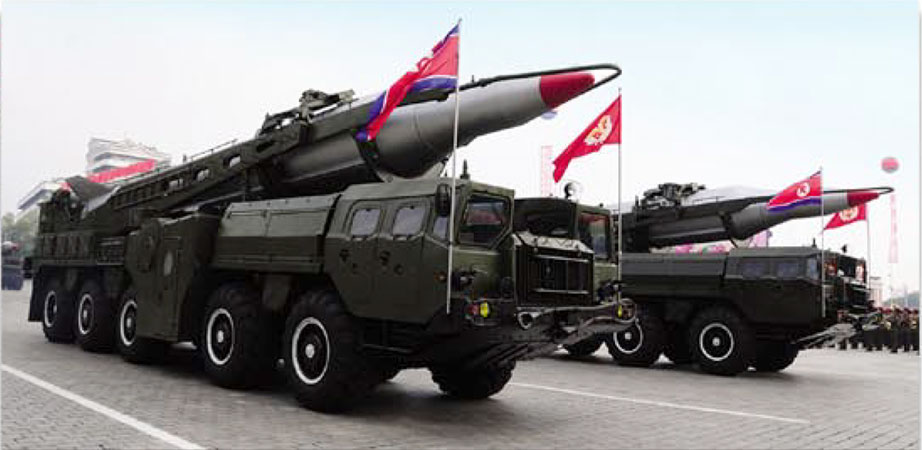
During October 1999, there was a report that a Taepodong-1 battalion with nine launchers was deployed at Sino-ri. However, this report was quickly denied by South Korea’s Ministry of National Defense.20 This denial makes sense as the Taepodong-1 may have never been operationally deployed. From the late 1990s through 2006, the U.S. did not view the system as being operational, and in 2009, the National Air and Space Intelligence Center (NASIC) dropped it from the intermittently published Ballistic and Cruise Missile Threat report.21 Almost all subsequent references to the Sino-ri missile operating base refer to Nodong (Rodong) missiles.
“…the North recently deployed Rodong-1 missiles at four battalion groups in two strategic regions. …one at Sino-ri, north of its capital Pyongyang and three other units at Tugol… ‘One battalion is thought to have nine launchers for Rodong-1 missiles’…”22
To accommodate the Nodong missiles, the infrastructure at Sino-ri continued to expand with the construction of barracks, support facilities, missile support facilities, and a new headquarters built in Mipa-dong. Among the more significant missile support facilities constructed were two large drive-through vehicle sheds and an adjacent vehicle storage facility 500 meters west of Konggyong-dong.23
As the Nodong unit was established at the Sino-ri missile operating base, it displaced the existing Hwasong-5/-6 unit, which appears to have been redeployed to the new missile operating bases constructed along the DMZ during the late 1980s and early 1990s.24
Subsequently, construction was initiated on a series of additional ballistic missile operating bases within the northern provinces that would continue into the early 2000s and form what has become known as the strategic missile belt. These new bases were intended to house both additional Nodong-1 units and newly established units to be equipped with the forthcoming Taepodong-1 MRBM or other systems.25
Referencing the Sino-ri missile operating base, the South Korean Ministry of National Defense stated in March 2001 that,
“The Rodong battalion, located at Sino-ri, is reportedly equipped with nine missile-launch pads. Considering that each launch pad can contain about four missiles, the battalion is estimated to have a total of 40 missiles at its disposal.”26
The KPA reportedly conducted its first combined “Command Post Exercise (CPX)” with elements from both the Nodong and SCUD brigades during 2002. As the reported headquarters of the Nodong brigade, it is likely that the units based at Sino-ri participated in this exercise. Such CPXs would subsequently become part of the annual training exercise for KPA missile units.27
In early September 2004, increased activity was observed at a number of KPA bases around the country. While not initially considered significant, this activity subsequently expanded to include the Sino-ri Nodong unit.
“On 21 September 2004, at the Nodong base located in the hills at Sino-ri, Unjon County, North Pyongan Province, 100 kilometers north of Pyongyang, detected was activity such as movement from underground tunnel hangers of several TEL-mounted missiles, communications equipment, trucks loaded with fuel, and troop movements. U.S. reconnaissance satellite and wireless intelligence analysis revealed joint exercises were underway at not only the Sino-ri Base but at Musudan-ri and Wonsan missile launching units and army, navy, and air bases in about 10 locations with Sino-ri Base serving as the combat command center.”28
This activity was also assumed by some to be an indication of preparations for a Nodong missile training launch. However, no launch took place and this activity was finally assessed as being associated with a larger-than-normal nationwide exercise that included a major ballistic missile component.29
Four years later, during April 2008, the media again reported activity involving the Sino-ri Nodong unit that suggested an impending training launch. Once again, no launch took place and the South Korean Joint Chiefs of Staff quickly issued a cautionary statement that “[they had not] confirmed reports of signs of North Korea preparing for a missile launch in Shinori [Sino-ri].”30
Subsequently, minor infrastructure developments continued at the Sino-ri missile operating base. From 2010 to 2011, excavation for two large structures began 140 meters east of the T-shaped drive-through shed. By 2014, however, only one medium-sized storage shed was built, and this area has remained unchanged since.
In September 2012, the Sino-ri missile operating base was once again described as being the headquarters of a Nodong missile regiment.31 Two years later, a source of uncertain reliability stated that Nodong “…equipment is currently stored in a tunnel located in Sino-ri, Unjon-gun, Pyongbukdo.”32 Then on March 26, 2014, North Korea conducted a training launch of two Nodong missiles from the Sukchon area 30 kilometers southeast of Sino-ri.33 A former senior official from South Korea’s National Intelligence Service stated that it appeared that the launch was conducted by elements from the Sino-ri Nodong missile unit.34
The following year, between February 8 and May 8, 2015, North Korea conducted an extended ballistic missile training/testing campaign launching a total of 13 Hwasong-11 (KN-02), Hwasong-6, and Pukkuksong-1 (KN-11) missiles. In the middle of this campaign, in March, activity was observed at the Sino-ri missile operating base, where a Nodong missile was reportedly loaded onto a TEL. Though this action was thought to be an indicator of a forthcoming launch exercise of the system at the time, no launch was conducted.35
Most recently, in November 2018, it was suggested that the Sino-ri missile operating base might have a relationship with the development and fielding of the Pukkuksong-2.36 Such a relationship would appear logical as the TEL for the system was manufactured at the No. 95 Factory (40.053700° 125.218631°) 45 kilometers to the northwest. Additionally, crew and driver training for the TEL and ejection testing of the missile were undertaken at the nearby Iha-ri Driver Training and Test Facility (40.013205° 125.223421°). The relationship, if any, between the Sino-ri missile operating base and the Pukkuksong-2, however, remains to be determined.37
Organization
Satellite imagery from 2002-present indicates that unlike other known North Korean ballistic missile operating bases, which are nestled within narrow and steep mountain valleys, the primary facilities that constitute the Sino-ri missile operating base are distributed within a shallow valley and the rolling hills of Obong-san.38 Most of the base’s approximately 11.2 square kilometers includes unoccupied hills, agricultural activities that likely support the base, and seven small villages including Anyang-dong, Kinjae, Konggyong-dong, Mipa-dong, Ponghu, Tumi-dong and Sino-ri—for which the facility is named.
The base can be functionally divided among four broad activities: agricultural support, headquarters and support facilities, at least seven barracks areas distributed throughout the base, and missile support facilities including at least six—and potentially as many as nine—entrances to bunkers or underground facilities (UGFs) located primarily at the foot of Obong-san.
Located in the center of the Sino-ri missile operating base in the Mipa-dong and Konggyong-dong area are the base’s headquarters (with cultural/educational hall), main barracks area, main support facilities, several housing areas, and what appear to be the remnants of abandoned artillery or anti-aircraft artillery (AAA) revetments to the west. Located approximately 775 meters north-northeast of the headquarters are two UGF entrances. These are located on the south side of a small hill and spaced approximately 60 meters apart. Each entrance is about 4.5 meters wide and secured by two outward opening doors large enough to accommodate Nodong TEL/MELs and reload vehicles or technical vehicles.
Approximately 30-35 meters in front of each entrance is a large two-tiered rock and dirt berm built from the debris produced when excavating the UGFs. These tiered berms are approximately 18-20 meters high, 30-38 meters long, and intended to protect the entrances from artillery fire and aerial attack. It is uncertain whether adjacent UGF tunnels are internally connected so that vehicles can drive through them. At a minimum, per typical KPA practice, they are likely linked by small internally connected tunnels.
Located between each protective berm and UGF entrance is a small revetment that could be used by a TEL/MEL to conduct an emergency launch. KPA tactics and doctrine, however, call for TELs/MELs to disperse from missile operating bases during wartime operations. Due to the KPA’s practice of maintaining vegetation around entrances to UGFs and on associated protective berms, these UGF entrances are frequently difficult to identify in satellite imagery during spring and summer. Located approximately 1.2 kilometers southwest of the headquarters are approximately three UGF entrances, a potential UGF entrance, and an earth covered drive-through facility. The drive through facility was constructed during 2015-2017.
Limited historical satellite imagery suggests that there are three additional UGF or bunker entrances of varying sizes within the facility and at least six in the immediate surrounding areas. Several appear large enough to accommodate Nodong TEL/MELs, reload vehicles or technical vehicles.
On the north side of the base, spread out along the slopes of Obong-san, are the ballistic missile support facilities and several large barracks areas. Moving from west-to-east, the most significant of these support facilities are: three drive-through vehicle sheds and a vehicle storage facility, three four-bay hardened vehicle shelters, and, unique among missile operating bases, a driver training course.
On the western side of the ballistic missile support area, located within 250 meters of each other, are a small drive-through vehicle shed built between 2001 and 2015, two large drive-through vehicle sheds, a vehicle storage facility, and a storage building. Unlike the hardened drive-through facilities typical of other missile operating bases, these drive-through vehicle sheds measuring 20 meters by 10 meters, 23 meters by 33 meters, and 71 meters by 25 meters (“T-shaped”) and are not hardened. These are used for TEL/MEL storage, fueling, maintenance, and potentially missile loading operations. Though it is unknown whether there are entrances to UGFs within the two larger vehicle sheds built between 2015 and 2017, an excavation on the east side of the T-shaped drive-through vehicle shed suggests such an entrance may exist.
The vehicle storage facility has three buildings with a total of approximately 18 individual vehicle bays. About 140 meters east of the T-shaped drive-through shed is a storage shed built between 2010 and 2012 as well as an excavation for a second structure that was never completed. The sizes of the excavations for these two structures strongly suggest that they were originally intended for a larger project that was apparently cancelled. Immediately above this area are four old coastal defense artillery revetments that were constructed prior to 1970.
Moving approximately 800 meters to the northeast is an area that contains a vehicle storage facility, hardened vehicle storage shelter, and a support area that appears to include an earth-covered bunker. The vehicle storage facility is present in satellite imagery from the 1970s and has been modified over the years since then. Up until 2016, it had two parallel buildings with a total of approximately 24 individual vehicle bays.
During 2016, however, one building was demolished, leaving a single building with approximately 12 individual vehicle bays. Adjacent to the vehicle storage facility on its northwest corner is one of three four-bay hardened vehicle shelters. Believed to have been constructed sometime during the 1980s or early-1990s, each of the four bays is large enough to accommodate a single FROG-7, Hwasong-5/-6 or Nodong TEL/MEL. The small support area immediately west of the first hardened vehicle shelter appears to have been used for TEL servicing and appears to include an entrance to an earth-covered bunker.
Located approximately one kilometer to the east of this location are two additional four-bay hardened vehicle shelters. An adjacent building has had its roof replaced between 2017 and 2018. Located 450 meters further east of these two hardened vehicle shelters is a small driver training course that consists of a loop access road, elliptical loop road with a trail, and several revetments extending off of it to the east. This course allows TEL drivers to practice turning, backing, and entering/exiting a revetment. The small agricultural field immediately to the east may have also be used for driver training. Most of these facilities are challenging to detect in satellite imagery due to foliage except during the winter months. Imagery from April 2018 suggests that the driver training course has not been recently used.
There are a number of small potential UGF entrances, storage facilities, barracks, and a communication facility located within and immediately east and southeast of the generally accepted boundaries of the Sino-ri missile operating base. Some of the potential UGF entrances may, in fact, be small mining/quarrying activities or simply UGF projects that were started but never completed. A number of these are only readily visible in historical imagery. The association of these various activities to the Sino-ri missile operating base is unclear.
Satellite imagery acquired during the past eight years continues to show minor infrastructure changes to the base that are consistent with what is often seen at remote KPA bases of all types. As of December 2018, the base is active and being reasonably well-maintained by North Korean standards.
Oftentimes detailed organizational information for KPA ballistic missile units is nonexistent or, if available, is inconsistent. Preliminary data suggests that this is not only because of KPA camouflage, concealment, and deception practices (CCD), but also because KPA ballistic missile unit organizational structures do not necessarily neatly fit into Western organizational structures of battalion, regiment, and brigade. Rather, they may fit somewhere in between these Western structures or be organized around a base structure.
Regardless, since the late 1990s, the term “battalion” is most often used in reports describing the Nodong unit stationed at Sino-ri. These same reports, however, also cite 9 TELs/MELs, suggesting a regiment-sized unit consisting of a headquarters, service elements, and three missile battalions.39 Each battalion would thus consist of a headquarters, battery, and three firing batteries—each with a single Nodong-1 TEL/MEL. This would suggest a personnel strength of approximately 550 and 9 Nodong-1 TELs/MELs.40
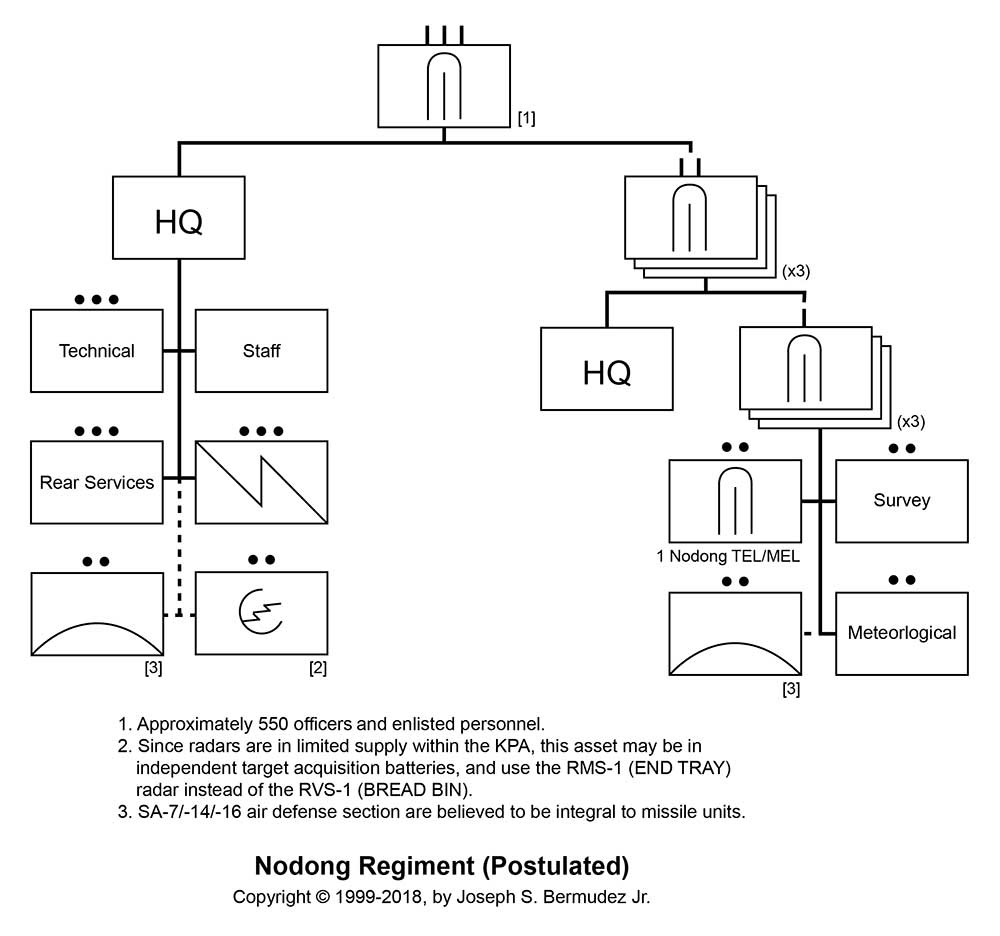
Despite the strategic importance of all the KPA’s ballistic missile operating bases and concerns of either pre-emptive or wartime airstrikes against these facilities, there are no readily visible fixed anti-aircraft artillery positions within the Sino-ri missile operating base. The Choe Chun-guk Anti-Aircraft Artillery Officer School (39.634412° 125.303926°) is, however, approximately 4.5 kilometers to the southwest and possesses a wide variety of AAA equipment. Sino-ri is also located within the overlapping air defense umbrella of four SA-2, two SA-3, and the nation’s two SA-5 surface-to-air missile (SAM) bases. Additionally, all KPA units of this size have organic air defense elements equipped with both light AAA and shoulder-fired SAMs (e.g., SA-7, SA-14, SA-16, etc.).
Sobaek-su Academy
The Sobaek-su (소백수) Academy (39.700598° 125.302307°) is located 7.4 kilometers northwest of the Sino-ri missile operating base and is the first of two facilities in the Myodu-san (Myodu Mountain) area, Chongju-gun (Chongju County), that are reported to be subordinate to the KPA Strategic Force and likely associated with the base.
Situated on the southwest slopes of the mountain at Tokhung-dong, the Sobaek-su Academy (a.k.a. Sobaek-su University) is believed to have been established sometime during the late 1950s or 1960s as an artillery officers’ school and gradually expanded during the 1970s and 1980s.41 While it is unclear when it assumed its current ballistic missile education mission, it appears to have been sometime during the early 2000s.
The academy is responsible for the higher education of Strategic Force officers and non-commissioned officers who attend a 3-year program to graduate. For non-commissioned officers this may also serve as an officer candidate school. The academy may also engage in research related to ballistic missile design and operations.42
The academy has its own business establishment abroad—the Sobaek-su Trading Company (소백수무역총회사) to independently raise funds needed to procure parts and military supplies for the academy and the Strategic Force.43 It is unclear, however, whether this Sobaek-su Trading Company is the same as the Chosun Sobaeksu United Corporation (조선소백수연합회사) which has been placed under sanctions in the United Kingdom and mentioned in the 2017 United Nations Security Council’s Panel of Experts Report. 44
Satellite imagery acquired during the past fifteen years shows that there was construction of a new cultural/education hall between 2004-2011. Since that time, however, there have only been very minor infrastructure changes to the academy that are consistent with what is typical of facilities of this type. As of late 2018, the facility encompasses approximately 0.62 square kilometers, and in addition to the classrooms, dormitories, and typical support facilities, there is a vehicle storage facility immediately to the northwest and what appears to be a UGF entrance immediately to the north. The academy is active and being well-maintained by North Korean standards.
Staff and students from the Sobaek-su Academy are also reported to make use of the nearby Myodu-san training area.
Myodu-san Training Area
The Myodu-san (묘두산) training area (39.707030° 125.314844°) is located 7.7 kilometers northwest of the Sino-ri missile operating base and is the second of two facilities in the Myodu-san (Myodu Mountain) area, Chongju-gun, that are reported to be subordinate to the Strategic Force and likely associated with the base.45 The precise nature of this relationship is unknown, although it may now serve as the primary field training facility for both the Sino-ri missile operating base and Sobaek-su Academy.
Situated on the northern slopes of Myodu-san, 1.2 kilometers northeast of Sobaek-su Academy, it is unknown when the area assumed a ballistic missile training mission. Although it could have served as a training area for ballistic missile units prior to 2008, up until that time it appears to have simply been a relatively flat agricultural area on the crest of the mountain. It was sometime between March and December 2008 that a construction project was undertaken to transform the approximately 0.21 square kilometer area into a formal training facility for ballistic missile units.
This project included the construction of a road network (that may also serve as a driver training course), excavation of five earth-covered drive-through vehicle shelters, what appear to be either two UGF entrances or incomplete drive-through vehicle shelters, a large earth-covered bunker, and six support buildings. The drive-through vehicle shelters are approximately 28 meters by 4 meters and are large enough to accommodate Nodong TEL/MELs or associated support vehicles. Since 2011, there have been a number of minor changes to the facility’s infrastructure, such as the razing or construction of support buildings. However, this activity appears to be typical of both training facilities of this time and agricultural facilities in remote areas. As of late 2018, the training area is active and being maintained.
The precise relationship between the Sino-ri missile operating base and the Myodu-san training area is unknown, although it is reported to be used for training exercises by students from the Sobaek-su Academy and missile units from the Sino-ri missile operating base.46
Research Notes
This report, as are the others in this series, is based on an ongoing study of the Korean People’s Army ballistic missile infrastructure begun by one of the authors, Joseph Bermudez, in 1985. This study is in turn based on numerous interviews with North Korean defectors, declassified documents, open source reporting, and government, defense, and intelligence officials around the world. Accuracy in any discussion of North Korea’s nuclear, biological, chemical, or ballistic missile programs is always a challenge and while some of the information used in the preparation of this study may eventually prove to be incomplete, or incorrect, it is hoped that it provides a new and unique look into the subject. The information presented here supersedes or updates previous works by Joseph Bermudez on these subjects.
The winter and spring satellite imagery used in this report was purposely selected for its absence of foliage, which allows for a more unobstructed and detailed view of the structures and activities within and around the Sino-ri missile operating base.
References
- The authors wish to thank Sang Jun Lee, research associate in the CSIS Korea Chair, Dana Kim, intern in the Korea Chair and the Dracopoulous iDeas Lab, and Young-Kyung Kim, intern in the Korea Chair, for their invaluable research in support of this project. Additional thanks go to Mr. Nathan Hunt and others for their post-publication comments. ↩
- Author interview data; Yu Yong-won, “Ballistic missile base, 13 totals in 3 belts,” Chosun Ilbo, November 14, 2018, http://news.chosun.com/site/data/html_dir/2018/11/14/2018111400327.html. “New Rodong-1 Deployment Confirmed,” Chosun Ilbo, July 19, 2003; “Ministry Says North Has Put More Missiles into Service,” Joongang Ilbo, July 19, 2003; “Article Cites U.S. Source as Saying DPRK Has Five Missile Bases,” Yomiuri Weekly, June 1, 2003, pp. 21-23; and “Article Cites U.S. Source as Saying DPRK Has Five Missile Bases,” Yomiuri Weekly, June 1, 2003, pp. 21-23.
The national designator for the missile operating base at Sino-ri is unknown and North Korea is not known to have ever made specific reference to its existence. The first reference to the use of the “Sino-ri” designation in relation to ballistic missile activity known to the author occurred in the early-1990s during conversations with defense and intelligence officials. Subsequently, during the late 1990s this designation began to appear in media reporting concerning North Korean missile facilities.
The transliteration of Korean place names into English is frequently challenging and often results in confusion and the Sino-ri missile operating base is no exception to this phenomenon. Among the alternative transliterations for Sino-ri are: Sino Ri, Sinori, Sino-dong, Shino-ri, Shinori and Shino Ri. For consistency and ease of reading Sino-ri and other places names used in this report are those accepted by the U.S. National Geospatial Intelligence Agency (NGA).
For a description of the North Korean missile belts see: Joseph Bermudez, Victor Cha and Lisa Collins, “Undeclared North Korea: Missile Operating Bases Revealed,” Beyond Parallel, November 12, 2018, https://beyondparallel.csis.org/north-koreas-undeclared-missile-operating-bases/. ↩ - Author interview data; Osamu Eya, “U.S.-South Korea ‘Operational Plan 5029’ Reaches Initial Stage of Enforcement,” Sapio, May 28, 2008; and Osamu Eya, “March Missile Launch Part of Winter Exercises,” Ryuichi Eoka Reports, no. 31, May 1, 2008. ↩
- Author interview data; “Strategy 21,” Journal of Korea Institute for Maritime Strategy, June 21, 2013, p. 65; North Korea’s Nuclear and Missile Programs, Asia Report No. 168, (Seoul: International Crisis Group), June 18, 2009, pp. 13-14; and Kovsh, Andrey, “North Korean Nuclear and Missile Development: Future Challenges and Options for the Asia Pacific Security Architecture,” Academy of Korean Studies, 6th Congress, September 25-26, 2012, http://congress.aks.ac.kr/korean/files/2_1357624367.pdf.
The Strategic Force is a branch-level command, on the same level as the Army, Navy, and Air and Anti-Air Forces. It likely performs a function similar to that of the People’s Liberation Army Rocket Force (formerly the Second Artillery Corps) or Russia’s Strategic Missile Troops (Strategic Rocket Forces). Defense White Paper, 2016, (Seoul: Ministry of National Defense), 2017, pp. 23, 26.
The Sino-ri missile operating base is likely responsible for other, yet to be determined, missions for the Strategic Force, or KPA in general, as the infrastructure is larger than that typically required for its known missions. ↩ - “North Korea, Launch of Nodong missile…The Trailer of the 4th Nuclear Test?” YTN, March 26, 2014. ↩
- Yu Yong-won. “Ballistic missile base, 13 Total in 3 Belts,” Chosun Ilbo, November 14, 2018, http://news.chosun.com/site/data/html_dir/2018/11/14/2018111400327.html. ↩
- Author interview data; National Photographic Interpretation Center, BLACK SHIELD Mission BX6847, 26 January 1968 (Washington, DC: Central Intelligence Agency), NPIC/R-63/68, (partially declassified), May 1968, p. 63, https://www.cia.gov/library/readingroom/collection/crest-25-year-program-archive, (hereafter: CREST); National Photographic Interpretation Center, IPIR KL0023 (Washington, DC: Central Intelligence Agency), IPIR KL0023, (partially declassified), July 23, 1969, (CREST); and National Photographic Interpretation Center, OAK Supplement Reports on Mission 1110, No. 3, (Washington, DC: Central Intelligence Agency), NPIC 8733, (partially declassified), June 19, 1970, (CREST). While the FROG-7 (original Soviet designation: 9K52 Luna-M launcher with the 9M21 rocket) is technically an artillery rocket, during the 1960s-1980s it was often described as a ballistic missile by many nations including North Korea. The KPA had acquired FROG-3/-5/-6 TELs from the Soviet Union during the 1960s. While the FROG-3/-5 (original Soviet designation: the 2K6 Luna launcher with the 3R9 rocket and 2K6 Luna launcher with the 3R10 rocket) are operational TELs the FROG-6 is a non-firing training aid (original Soviet designation: PV-65). ↩
- National Photographic Interpretation Center, FROG-7 Tactical Surface-to-Surface Missile Units, Sino Ri BKS A WPNS TEST FAC, North Korea, (Washington, DC: Central Intelligence Agency), Z-15827/82, (partially declassified), August 19, 1982, (CREST) and National Photographic Interpretation Center, Annual Index Photographic Exploitation Products, January-December 1982, Vol. 1 of 5, (Washington, DC: Central Intelligence Agency), (partially declassified), PEP-013/82, May 1983, p. 235, (CREST). ↩
- Author interview data. The Artillery Command would subsequently become known as the Artillery Bureau. The ballistic missile related elements of the Artillery Bureau would eventually evolve into the Strategic Force. ↩
- While there are formal KPA training areas many are often no more than just wide-open fields or flat sand bars along rivers such as the one described here at Komsan-dong. National Photographic Interpretation Center, FROG Training Komsan Dong Training Area SW 1 North Korea, (Washington, DC: Central Intelligence Agency), Z-10267/82, (partially declassified), February 1982, (CREST). ↩
- The original Soviet designation for the export Scud B missile is R-17E. ↩
- Author interview data. ↩
- Joseph Bermudez, Victor Cha and Lisa Collins, “Undeclared North Korea: Missile Operating Bases Revealed,” Beyond Parallel, November 12, 2018, https://beyondparallel.csis.org/north-koreas-undeclared-missile-operating-bases/; and Joseph Bermudez, Victor Cha and Lisa Collins, ” Undeclared North Korea: The Sakkanmol Missile Operating Base,” Beyond Parallel, November 12, 2018, https://beyondparallel.csis.org/undeclared-north-korea-sakkanmol-missile-operating-base/. ↩
- Author interview data. ↩
- Ibid. The precise timing of these developments is tentative. ↩
- Daniel A. Pinkston, The North Korean Ballistic Missile Program, (Carlisle Barracks: U.S. Army Strategic Studies Institute), 2008. P. 50
There is considerable confusion concerning the domestic and foreign designations of North Korea’s ballistic missile systems in the open source literature. One of the more comprehensive reviews of these designations, and the one adhered to here, is: Scott LaFoy, “The Hwasong that Never Ends,” Arms Control Wonk, August 28, 2017, http://www.armscontrolwonk.com/archive/1203797/the-hwasong-that-never-ends/. ↩ - Author interview data and Yi Yong-chong and Sol Myo-cha, “Ministry says North has put more missiles into service,” Joongang Ilbo, July 19, 2003; and Defense Intelligence Agency, A Primer on the Future Threat, The Decades Ahead: 1999-2020, (Defense Intelligence Agency: Washington, D.C.), 1999, (partially declassified), p. 79, (CREST). ↩
- Author interview data and “Further on DPRK Deploying Nodong Missile,” NHK, January 2, 1999. ↩
- “Lawmaker: DPRK ‘Fully Prepared’ for Biological War,” The Korea Times, September 29, 1999 and Chu Yong Chung, “North Korea Deploys Three Missiles Along the MDL” Chosun Ilbo, September 29, 1999, p. 1. ↩
- “NKorea-Missile,” Associated Press, October 25, 1999 and “S.Korea denies report North deploys missile units,” Reuters, October 25, 1999. ↩
- National Air and Space Intelligence Center, Ballistic and Cruise Missile Threat, (Wright-Patterson Air Force Base: National Air and Space Intelligence Center), NASIC-1031-0985-09, April 2009, p. 17; National Air and Space Intelligence Center, Ballistic and Cruise Missile Threat, (Wright-Patterson Air Force Base: National Air and Space Intelligence Center), NASIC-1031-0985-06, March 2006, p. 10; Defense Intelligence Agency, A Primer on the Future Threat, The Decades Ahead: 1999-2020, (Defense Intelligence Agency: Washington, D.C.), 1999, (partially declassified), p. 79, (CREST); Kim Yong-suk, “The entire Northeast Asia in the range of ‘Taepodong’,” Kookmin Ilbo, February 13, 2002; and Robert D. Walpole, North Korea’s Taepo Dong Launch and Some Implications on the Ballistic Missile Threat to the United States, Presentation at the Center for Strategic and International Studies, December 8, 1998. ↩
- “S.Korea Denies Report North Deploys Missile Units,” Reuters, October 25, 1999. ↩
- Author interview data. ↩
- Ibid.; Joseph Bermudez, Victor Cha and Lisa Collins, “Undeclared North Korea: Missile Operating Bases Revealed,” Beyond Parallel, November 12, 2018, https://beyondparallel.csis.org/north-koreas-undeclared-missile-operating-bases/; and Joseph Bermudez, Victor Cha and Lisa Collins, ” Undeclared North Korea: The Sakkanmol Missile Operating Base,” Beyond Parallel, November 12, 2018, https://beyondparallel.csis.org/undeclared-north-korea-sakkanmol-missile-operating-base/. ↩
- “DPRK Deploys 100 Nodong-1 Missiles Since 1998,” Choson Ilbo, March 2, 2001; Chu Yong Chung, “North Korea Deploys Three Missiles Along the MDL,” Chosun Ilbo, September 29, 1999, p. 1; “N.K. building bases for Scud-C missiles,” Korea Herald, October 28, 1999; Hwang Yang-jun, “North Korea Builds Six Bases for 550 km-Range Missiles,” Hankook Ilbo, October 27, 1999; Kim Jong-hoon, “Announcement of the ’99 Defense White Paper – North Korean troops increased in number to 1.17 million,” Kyunghyang Shinmun, October 13, 1999; Kim Young-rep, “North, Holding 5,000 Tons of Chemical Weapons,” Munhwa Ilbo, October 13, 1999; “DPRK Building ‘At Least Five’ Underground Missile Sites,” Yonhap, January 8, 1999; “Pyongyang Found Constructing 5 Underground Facilities,” Yomiuri Shimbun, January 8, 1999; “DPRK Said to Deploy Missiles at More Than 10 Sites,” Yonhap, January 6, 1999; “DPRK Deploying, Exporting Medium-Range Missiles,” Kyodo, January 2, 1999; and “U.S. Military Detects Underground Bases in DPRK,” NHK, December 8, 1998. ↩
- “ROK Defense Ministry Claims DPRK Building Missile Power as World Debates U.S. Plan,” Joongang Ilbo, March 12, 2001, p. 2; and “NK Deploys 100 Rodong-1 Missiles,” Digital Chosun, March 2, 2001. ↩
- Yu Kang-mun, “Activity of North Korea’s Missile Launch Preparations,” Hankyoreh, September 24, 2004, https://news.naver.com/main/read.nhn?mode=LSD&mid=sec&sid1=100&oid=028&aid=0000079504. ↩
- Osamu Eya, “Analysis of Unusual North Korean Behavior – Unexpected Progress Made by North Korea on Miniaturizing Nuclear Weapons,” Seiron Magazine, September 2007, pp. 204-212. ↩
- Author interview data; Osamu Eya, “Analysis of Unusual North Korean Behavior – Unexpected Progress Made by North Korea on Miniaturizing Nuclear Weapons,” Seiron Magazine, September 2007, pp. 204-212; “DPRK Army Unusually Active Since Explosion,” The Daily Yomiuri, September 27, 2004; “More Activity Seen in DPRK – But Chances of Actual Rodong Launch Seen as ‘Slim’,” The Daily Yomiuri, September 26, 2004; “Rodong Missile Units Seen on Move in N. Korea’s Northwest,” Kyodo World Service, September 24, 2004; and Lee Jong-heon, “Analysis: Another N. Korean missile launch?” United Press International, September 24, 2004. ↩
- Osamu Eya, “U.S.-South Korea ‘Operational Plan 5029’ Reaches Initial Stage of Enforcement,” Sapio, May 28, 2008; “Signs of Activity’ at N.Korean Missile Launch Site,” Chosun Ilbo, April 14, 2008; and “The North Preparing Firing of ‘No Dong’ on 21 Apr …To Pose a Threat to Summit Talks?” Zakzak, April 16, 2008. ↩
- Kovsh, Andrey, “North Korean Nuclear and Missile Development: Future Challenges and Options for the Asia Pacific Security Architecture,” Academy of Korean Studies, 6th Congress, September 25-26, 2012, http://congress.aks.ac.kr/korean/files/2_1357624367.pdf; and “Strategy 21,” Journal of Korea Institute for Maritime Strategy, June 21, 2013, p. 65. ↩
- Cho Kyong-ha, “DPRK Missile Base Location, Data Obtained,” Free North Korea Radio, March 4, 2014. ↩
- Choe Sang-Hun, “North Korea Launches Two Midrange Missiles,” New York Times, March 25, 2014, http://www.nytimes.com/2014/03/26/world/asia/north-korea-launches-two-midrange-missiles.html; “N. Korea fires two ballistic missiles,” Korea Herald, March 26, 2018, http://www.koreaherald.com/view.php?ud=20140326000030; and “NK fires 2 ballistic missiles timed with S. Korea-US-Japan summit,” Korea Times, March 26, 2014, http://koreatimes.co.kr/www/news/nation/2014/03/113_154081.html. ↩
- “North Korea, launch of Nodong missile…The Trailer of the 4th Nuclear Test?” YTN, March 26, 2014. ↩
- Kim Kwang-su, “ROK-U.S. EDPC to be Held Again Next Week,” Hankook Ilbo, March 10, 2015, http://www.hankookilbo.com/News/Read/201503100471107482. ↩
- Yu Yong-won, “Ballistic missile base, 13 Total in 3 Belts,” Chosun Ilbo, November 14, 2018, http://news.chosun.com/site/data/html_dir/2018/11/14/2018111400327.html. ↩
- Joseph S. Bermudez Jr., “North Korea Razing Key Missile Test Stand,” 38 North, June 6, 2018, https://www.38north.org/2018/06/ihari060618/; and Joseph S. Bermudez Jr., “New Developments in North Korea’s Ballistic Missile Infrastructure—What Does it Mean for the Future?” 38 North, May 2, 2017, https://www.38north.org/2017/05/missile050217/. ↩
- Greenhouses and agricultural support facilities are common within KPA bases as all units have a varying level of responsibility for growing their own food. ↩
- Author interview data; Yu Yong-won, “Ballistic missile base, 13 Total in 3 Belts,” Chosun Ilbo, November 14, 2018, http://news.chosun.com/site/data/html_dir/2018/11/14/2018111400327.html; “North Korea, launch of Nodong missile…The Trailer of the 4th Nuclear Test?” YTN, March 26, 2014; Osamu Eya, “U.S.-South Korea ‘Operational Plan 5029’ Reaches Initial Stage of Enforcement,” Sapio, May 28, 2008; “Signs of Activity’ at N.Korean Missile Launch Site,” Chosun Ilbo, April 14, 2008; Yi Yong-chong and Sol Myo-cha, “Ministry says North has put more missiles into service,” Joongang Ilbo, July 19, 2003; “ROK Defense Ministry Claims DPRK Building Missile Power as World Debates U.S. Plan,” Joongang Ilbo, March 12, 2001, p. 2; “NK Deploys 100 Rodong-1 Missiles,” Digital Chosun, March 2, 2001; “S.Korea Denies Report North Deploys Missile Units,” Reuters, October 25, 1999; “Lawmaker: DPRK ‘Fully Prepared’ for Biological War,” The Korea Times, September 29, 1999; and Chu Yong Chung, “North Korea Deploys Three Missiles Along the MDL” Chosun Ilbo, September 29, 1999, p. 1. Occasionally, some sources will also state that the Nodong unit based at Sino-ri is a battalion with 12 TEL/MELs. ↩
- Author interview data. Such an organization would generally be identified as a brigade in western terminology. By comparison Cold-war era Soviet Scud/Scaleboard brigades had a personnel strength of approximately 1,200 and 9 TELs. U.S. Army, Opposing Forces: Europe, FM 30-102, 1 June 1973, p. 13-6. If there were a 4th firing battery in each battalion this would brig the total number of TELs/MELs to 12. ↩
- Author interview data. The Sobaek-su Academy is named after the Sobaek-su Valley on the southern slopes of Paektu-san that is famous in the lore of the Anti-Japanese Partisans as the location for a secret military base during the struggle against the Japanese and the birthplace of Kim Jong-il was supposedly born in a log cabin here. The academy may sometimes be identified as the Tokhung-dong Academy. ↩
- Ibid; and “Lee Yun Gul’s Real Kim Jong-un Story,” Ilyo Sinmun, November 25, 2015. ↩
- Ibid. ↩
- Her Majesty’s Treasury, Consolidated List of Financial Sanctions Targets in the UK, (London: Office of Financial Sanctions Implementation), November 8, 2018, pp. 5 and 20; and United Nations Security Council. Report of the Panel of Experts Established Pursuant to Resolution 1874 (2009), (New York: United Nations Security Council), S/2017/150, February 27, 2017, p. 56. ↩
- Author interview data. This information is tentative and requires further verification. ↩
- Ibid. ↩

